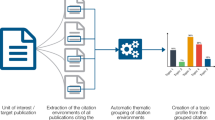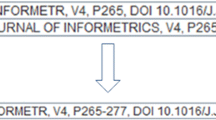Abstract
The purpose of this study is to determine the usage patterns of core journals by scholars, and to address the differences among various academic disciplines. Thus, the references of 11,230 corresponding authors for the past 35 years from the world’s top five highly cited universities and institutions were analyzed. To build robust models of information scattering, we need a deeper understanding of this phenomenon. The results show that core journals usage is a social phenomenon, in exactly the same way as Bradford’s law, Zipf’s law and Lotka’s law. The analysis of author references shows that if core scientific journals are arranged in order of decreasing productivity, then they could be divided into a small group of highly cited periodicals and a large group of minimally cited ones. Scholars may do browsing and similar information-seeking activities to form their core journals, and the findings may support Bates’s hypothesis that Bradford’s core zone is best searched by browsing. Bradford’s law and relevant research may consequently help to solve many of the practical problems that practitioners of the profession face, particularly in collection development in libraries, and help users to gather highly scattered information.
Similar content being viewed by others
Notes
In this study, citing/citation is used as a proxy for usage. Authors use the articles they cite, but they use much more than they choose to cite.
In this study, references denote the items offered in the reference section of author’s documents.
In this study, the word document refers to the ISI Thomson bibliographic record information, which comprises a paper’s items such as authors, title, affiliations, abstracts, keywords, references. These items were extracted from the original paper’s full-text. The type of each ISI Thomson document could be article, meeting abstract, proceedings paper, review, editorial material, book review, letter, note, etc.
The ESI is an ISI Thomson product that determines the influential individuals, institutions, papers, publications, and countries in their field of study. In the case of institutions, the ESI aggregate publications and citations at the institutional level and measures the institutional output and prestige attributable to the affiliated researchers.
In this study, author’s citing journals refers to journals, which have been cited in reference section of author’s documents.
References
Bailón-Moreno, R., Jurado-Alameda, E., Ruiz-Baños, R., & Courtial, J. P. (2005). Bibliometric laws: Empirical flaws of fit. Scientometrics, 63(2), 209–229.
Basu, A. (1992). Hierarchical distributions and Bradford’s law. Journal of the American Society for Information Science, 43(7), 494–500.
Bates, M. J. (2002). Speculations on browsing, directed searching, and linking in relation to the Bradford distribution. In H. Bruce, R. Fidel, R. Ingwersen, & P. Vakkari (Eds.), Emerging frameworks and methods: Proceedings of the fourth international conference on conceptions of library and information science (CoLIS4) (pp. 137–150). Greenwood Village: Libraries Unlimited.
Bensman, J. S. (2001). Bradford’s law and fuzzy sets: statistical implications for library analyses. International Federation of Library Associations (IFLA) Journal, 27(4), 238–246.
Bhavnani, S.K. & Wilson, C.S. (2010). Information scattering. Encyclopedia of library and information sciences (3rd ed.). doi:10.1081/E-ELIS3-120043255.
Bradford, S. C. (1934). Sources of information on specific subjects. Engineering, 137, 85–86.
Brookes, B. C. (1979). The Bradford law: A new calculus for the social sciences? Journal of the American Society for Information Science, 30, 233–234.
Chang, S. J., & Rice, R. E. (1993). Browsing: A multidimensional framework. Annual Review of Information Science and Technology, 28, 231–276.
Dillon, I. F., & Hann, K. L. (2002). Are researchers ready for the electronic-only journal collection?: Results of a survey at the university of Maryland. Libraries and the Academy, 2(3), 375–390.
Drott, M. C. (1981). Bradford’s law: theory, empiricism and the gaps between. Library Trends, 30(1), 41–52.
Drott, M. C., & Griffith, B. C. (1978). An empirical examination of Bradford’s law and the scattering of scientific literature. Journal of the American Society for Information Science, 29(5), 238–246.
Herbertz, H. B., & Muller-Hill, B. (1995). Quality and efficiency of basic research in molecular biology: a bibliometric analysis of thirteen excellent research institutes. Research Policy, 24, 959–979.
Hubert, J. J. (1977). Bibliometric models for journal productivity. Social Indicators Research, 4, 441–473.
Jamali, H. R., & Nicholas, D. (2010). Interdisciplinarity and the information-seeking behavior of scientists. Information Processing and Management, 46, 233–243.
Jamali, H. R., Nicholas, D., & Huntington, P. (2005). The use and users of scholarly e-journals: a review of log analysis studies. Aslib Proceedings: New Information Perspectives, 57(6), 554–571.
Jin, B., Rousseau, R., Suttmeier, R. P., & Cao, C. (2007). The role of ethnic ties in international collaboration: the overseas chinese phenomenon. In D. Torres-Salinas & H. F. Moed (Eds.), Proceedings of the ISSI 2007: 11th international conference of the International society for scientometrics and informetrics (pp. 427–436). CSIC: Madrid.
Joswick, K., & Stierman, J. (1997). The core list mirage: A comparison of the journals frequently consulted by faculty and students. College & Research Libraries, 58, 48–55.
Law, E., Klobučar, T., & Pipan, M. (2006). User effect in evaluating personalized information retrieval systems. In W. Nejdl & K. Tochtermann (Eds.), Innovative approaches for learning and knowledge sharing (Vol. 4227, pp. 257–271). Berlin: Springer. doi:10.1007/11876663_21.
Maglaughlin, K. L., & Sonnenwald, D. H. (2005). Factors that impact interdisciplinary natural science research collaboration in academia. In: P. Ingwersen, & B. Larsen (Eds.), Proceedings of the ISSI 2005—the 10th international conference of the International society for scientometrics and informetrics, Stockholm, Sweden, July 24–28th. Stockholm: Karolinska University Press.
Mayr, P. (2008). An evaluation of Bradfordizing effects. In: H. Kretschmer & F. Havemann (Eds.), Proceedings of WIS 2008: Fourth international conference on webometrics, informetrics and scientometrics ninth COLLNET meeting, Berlin. Retrieved May 20, 2010 from http://www.collnet.de/Berlin-2008/MayrWIS2008ebe.pdf, Preprint arXiv:0812.0262.
Nicholas, D., Huntington, P., & Jamali, H. R. (2007). Diversity in the information-seeking behaviour of the virtual scholar: institutional comparisons. Journal of Academic Librarianship, 33(6), 629–638.
Nicholas, D., Rowlands, I., Huntington, P., Jamali, H. R., & Salazar, P. H. (2010). Diversity in the e-journal use and information-seeking behaviour of UK researchers. Journal of Documentation, 66(3), 409–433.
Nicolaisen, J., & Hjørland, B. (2007). Practical potentials of Bradford’s law: A critical examination of the received view. Journal of Documentation, 63(3), 359–377.
Palmer, C. L., Teffeau, L. C., & Pirmann, C. M. (2009). Scholarly information practices in the online environment: Themes from the literature and implications for library service development. Report commissioned by OCLC research. Retrieved September 13, 2009 from http://www.oclc.org/programs/publications/reports/2009-02.pdf.
Pope, A. (1975). Bradford’s law and the periodical literature of information science. Journal of the American Society for Information Science, 26, 207–213.
Pretschner, A. (1999). Ontology based personalized search. Master’s thesis, University of Kansas.
Sathe, N. A., Grady, J. L., & Giuse, N. B. (2002). Print versus electronic journals: A preliminary investigation into the effect of journal format on research processes. Journal of the Medical Library Association, 90(2), 235–243.
Shen, X., Tan, B., & Zhai, C. (2005). Implicit user modeling for personalized search. Proceedings of the 14th ACM international conference on Information and knowledge management (CIKM ‘05). New York: ACM. doi:10.1145/1099554.1099747.
Stokes, T. D., & Hartley, A. (1989). Coauthorship, social structure and influence within specialties. Social Studies of Science, 19(1), 101–125.
Talja, S., & Maula, H. (2003). Reasons for the use and non use of electronic journals and databases: A domain analytical study in four scholarly disciplines. Journal of Documentation, 59(6), 673–691.
Talja, S., Vakkari, P., Fry, J., & Wouters, P. (2007). Impact of research cultures on the use of digital library resources. Journal of the American Society for Information Science and Technology, 58(11), 1674–1685.
Tenopir, C. (2003). Use and users of electronic library resources: An overview and analysis of recent research studies. Washington, DC: Council on Library and Information Resources.
Tenopir, C. (2007). Digging deeper into e-journal use: Outcomes, value, and interdisciplinary reading. The consortium on core electronic resources (CONCERT) meeting, Taiwan, 14–15 November. stpi.org.tw.
Unsworth, J. (2000). Scholarly primitives: What methods do humanities researchers have in common, and how might our tools reflect this? Symposium on humanities computing: Formal methods, experimental practice. London: King’s College.
Vakkari, P. (2006). Trends in the use of digital libraries by scientists in 2000–2005: A case study of FinELib. In Grove, A. (ed.) Proceedings 69th annual meeting of the American society for information science and technology: 43. Medford: Information Today.
Vakkari, P., & Talja, S. (2005). The influence of the scatter of literature on the use of electronic resources across disciplines: A case study of FinELib. In A. Rauber, S. Christodoulakis, & A. M. Tjoa (Eds.), Research and advanced technology for digital libraries: Proceedings of the 9th European conference, lecture notes in computer science (pp. 205–217). Berlin: Springer.
Vickery, B. C. (1948). Bradford’s law of scattering. Journal of Documentation, 4(3), 198–203.
White, H. D. (1981). ‘Bradfordizing’ search output: how it would help online users. Online Review, 5(1), 47–54.
Acknowledgment
The authors would like to thank the anonymous reviewers for their valuable comments.
Author information
Authors and Affiliations
Corresponding author
Rights and permissions
About this article
Cite this article
Bigdeli, Z., Gazni, A. Authors’ sources of information: a new dimension in information scattering. Scientometrics 92, 505–521 (2012). https://doi.org/10.1007/s11192-011-0609-1
Received:
Published:
Issue Date:
DOI: https://doi.org/10.1007/s11192-011-0609-1




